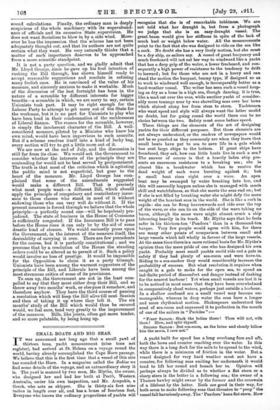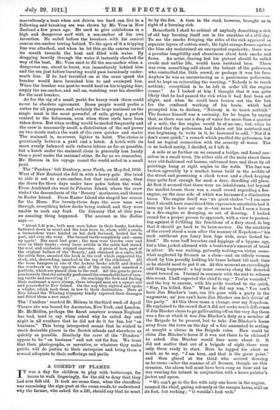SMALL BOATS AND BIG SEAS.
IT was announced not long ago that a small yawl of thirteen tons, yacht measurement (nine tons net register), had arrived at St. Helena on a voyage round the world, having already accomplished the Cape Horn passage. We believe that this is the first time that a vessel of this size has rounded the Horn. In a magazine called the Zodiac we find some details of the voyage, and an extraordinary story it is. The yawl is manned by two men, Mr. Blythe, the owner, who designed her and had her built at Perth, Western Australia, under his own inspection, and Mr. Arapakis, Greek, who acts as skipper. She is thirty-six feet nine inches in length over all, and has a beam of fourteen feet, Everyone who knows the ordinary proportions of yachts will recognize that she is of remarkable tubbiness. We are not told what her draught is, but from a photograph we judge that she is an easy-draught vessel. The great beam would give her stiffness in spite of the lack of much keel or weight below water. All the measurements point to the fact that she was designed to ride on the sea like a cork. No doubt she has a very lively motion, but she must be a dry ship, as sailors say. A vessel of great buoyancy and much freeboard will not eat her way to windward like a yacht that has a deep grip of the water, a lower freeboard, and con- sequently a high power of resistance to the tendency to drift to leeward ; but for those who are not in a hurry and can stand the motion the buoyant, heamy type, if designed so as to work to windward well enough, is incomparably better as a hard-weather vessel. The writer has seen such a vessel keep- ing as dry as a bone in a high sea, though dancing, it is true, like a mad cat over the seas, while another yacht of consider- ably more tonnage near by was shovelling seas over her bows which sluiced along her from stem to stern. Yachtsmen who want speed and style will always want the latter model no doubt, but for going round the world there can be no choice between the two. Safety must come before speed.
These things are the elements of the art of designing yachts for their different purposes. But these elements are not always understood, or the readers of newspapers would not be so puzzled as they commonly are when they learn that small boats have put to sea to save life in a gale which has sent large ships to the bottom. If great ships have foundered, they ask, how can little boats live in such a sea ? The answer of course is that a heavily laden ship pre- sents an enormous resistance to a breaking sea ; she is almost like a breakwater which has to receive the dead weight of each wave bursting against it; but a small boat rises right over a wave. An open boat may be swamped by water breaking into her, and this will assuredly happen unless she is managed with much skill and watchfulness, so that she meets the seas end on ; but if she is not filled by breaking water she might defy the mere weight of the heaviest seas in the world. She is like a cork in rapids : she can be flung heavenwards and ride over the top of the wave, or she can lie on the side of the wave taking no harm, although the same wave might almost crush a ship labouring heavily in its track. Mr. Blythe says that he feels safer in his thirteen-ton Pandora' than in a thousand-ton barque. Very few people would agree with him, for there are many other points of comparison between small and large vessels which tell wholly in favour of the large vessels. At the same time there is a more rational basis for Mr. Blythe's opinion than the mere pride of one who has designed his own yacht. Probably most small yachts could ride out a gale in safety if they had plenty of sea-room and were hove-to. Riding to a sea-anchor they would considerably increase the probability of success. But what resolution it requires when caught in a gale to make for the open sea, to spend an indefinite period of discomfort and danger instead of dashing for the nearest harbour ! Yet when small vessels are lost it is to be noticed in most cases that they have been overwhelmed in comparatively shoal waters, perhaps just outside a harbour. In a shallow confused sea a small vessel may become un- manageable, whereas in deep water the seas have a longer and more rhythmical motion. Shakespeare understood the need of sea-room and expressed it to perfection in the mouth of one of the sailors in " Pericles "
"Freer Samoa: Slack the bolins there ! Thon wilt not, wilt thou ? Blow, and split thyself.
Sacown Samoa : But sea-room, an the brine and cloudy billow kiss the moon. I care not."
A yacht built for speed has a long overhang fore and aft, both the bows and counter reaching over the water. In this way there is a long deck for the sails to be spread to the wind, while there is a minimum of friction in the water. But a vessel designed for very hard weather must not have a counter, for following seas smiting her underneath it would tend to lift her round and broach her to. Opinion will perhaps always be divided as to whether a flat stern or a sharp stern is the better in a following sea; the owner of a Thames bawley might swear by the former and the coxswain of a lifeboat by the latter. Both are good in their way, for both seem to make following seas that threaten to "poop " the vessel fall harmlessly away. The Pandora' has a flat stern. How
marvellously a boat when not driven too hard can live in a following and breaking sea was shown by Mr. Voss in New Zealand a few years ago. He used to give exhibitions in a high and dangerous surf with a sea-anchor of his own invention. He sailed before the breakers with his conical canvas sea-anchor towing behind. To the apex of it a tripping line was attached, and when he let this go the canvas turned its mouth towards the boat and filled with water. By dragging heavily through the water it instantly checked the way of the boat. Mr. Voss used to fill the sea-anchor when a dangerous sea., about to burst, was immediately behind him' and the sea just before bursting would pass harmlessly under- neath him. If he had travelled on at the same speed the
breaker would have broached him to and swamped him. When the breaker was past be would haul on his tripping line,
empty the sea-anchor, and sail on, watching over his shoulder for the next breaker.
As for the rig of a small yacht for heavy work there could never be absolute agreement. Some people would prefer a cutter for all purposes, and certainly the large mainsail on the single mast is the most powerful of sails, giving a perfect control to the helmsman, even when three reefs have been taken down. But when reefing would be needed frequently and the crew is necessarily small, a distribution of the sail power on two masts makes the work of the crew quicker and easier The mainsail is, moreover, lighter to hoist. The choice is practically between a yawl and a ketch. A ketch with its more evenly balanced sails reduces labour as far as possible, but a ketch under the mainsail alone is generally less bandy than a yawl under the mainsail alone. So far as we remember, Mr. Slocum in his voyage round the world sailed in a small yawl.
The ' Pandora' left Bunbury, near Perth, on May 3rd, 1910.
West of New Zealand she fell in with a heavy gale. She tried to ride it out to a sea-anchor, but that carried away, then she drove for three days under bare poles before the wind. From Auckland she went to Pitcairn Island, where the crew visited the descendants of the 'Bounty' mutineers, and thence to Easter Island. From Easter Island she shaped her course for the Horn. For twenty-three days the crew were wet through, everything below decks being soaked, and they were unable to cook any food. On January 21st of this year an amazing thing happened. The account in the Zodiac says :—
" About 3.45 p.m., both men were below in their bunks, hatches battened down as usual and the boat hove to, when, wall a crash, a tremendous wave landed on her deck forward, heeled her to port, and over she went. She turned turtle completely and—came up again! Her mast had gone ; the men were thrown over and over in their bunks ; every loose article in the cabin had struck the roof, and confusion reigned supreme. A piece of iron, part of the original ballast of the ` Bounty,' and obtained as a curio, left the cabin floor, smashed the hook in the roof which supported the clock, and, descending, smashed in the top of the sideboard. All the loose hampers in one of the lockers broke adrift and dented the woodwork on the opposite side of the cabin and smashed a porthole, which are placed close to the roof. All this goes to prove conclusively that she actually performed the remarkablefeat of turn- ing turtle and surviving it ! . . . On reaching the deck and finding their mainmast a mere stump, these intrepid men set a square sail and proceeded to New Island. On the way they sighted and spoke a whaler, which took them in tow to their destination. Here at New Island the Whaling Company kindly repaired their damages and fitted them a new mast."
The randora ' reached St. Helena in the third week of April Thence she was bound for Ascension, New York, and London. Mr. McMullen, perhaps the finest amateur seaman England has had, used to say when asked why he sailed day and night in all weathers that he did not do it for fun, but "on business." This being interpreted meant that he wished to reach desirable places in the Scotch islands and elsewhere as quickly as possible. Similarly the crew of the ' Pandora' appear to be " on business" and not out for fun. We trust that their photographs, or narrative, or whatever they make public will do justice to their enterprise and bring them a reward adequate to their sufferings and perils.







































 Previous page
Previous page